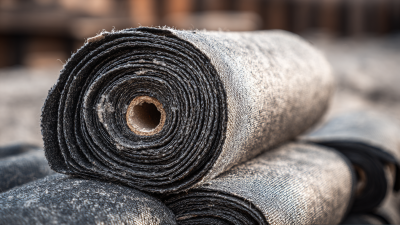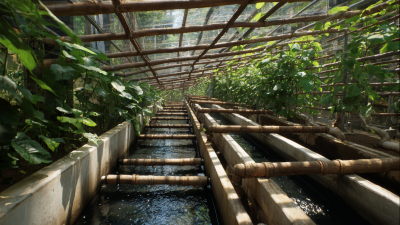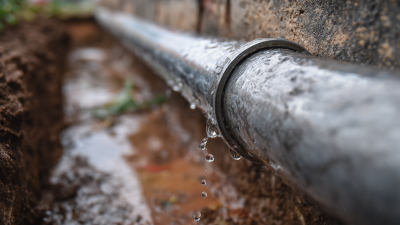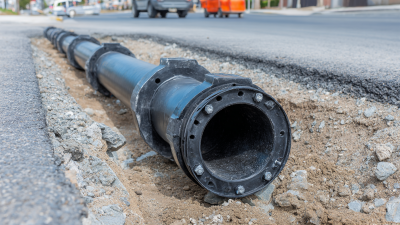 Geotextile fabric has become an indispensable component in the fields of civil engineering, construction, and landscaping due to its remarkable versatility and durability. According to a report from MarketsandMarkets, the global geotextiles market is projected to reach USD 10.5 billion by 2025, growing at a CAGR of 10.2% from 2020. This surge can be attributed to the increasing demand for sustainable construction practices and enhanced infrastructure projects. Geotextile fabric serves various applications, including erosion control, soil stabilization, and drainage solutions, fundamentally revolutionizing how we approach land management. In this ultimate guide, we will delve into the diverse applications and benefits of geotextile fabric, allowing you to harness this innovative material effectively in your projects, whether they involve road construction, environmental restoration, or landscaping.
Geotextile fabric has become an indispensable component in the fields of civil engineering, construction, and landscaping due to its remarkable versatility and durability. According to a report from MarketsandMarkets, the global geotextiles market is projected to reach USD 10.5 billion by 2025, growing at a CAGR of 10.2% from 2020. This surge can be attributed to the increasing demand for sustainable construction practices and enhanced infrastructure projects. Geotextile fabric serves various applications, including erosion control, soil stabilization, and drainage solutions, fundamentally revolutionizing how we approach land management. In this ultimate guide, we will delve into the diverse applications and benefits of geotextile fabric, allowing you to harness this innovative material effectively in your projects, whether they involve road construction, environmental restoration, or landscaping.
Geotextile fabrics are versatile materials commonly used in civil engineering and construction projects, offering a range of types that cater to specific applications. The primary types of geotextiles include woven, non-woven, and knitted fabrics.
Woven geotextiles are crafted from interlaced fibers, resulting in a strong, durable product ideal for reinforcing soil and providing separation in applications such as road construction and retaining walls. Their high tensile strength makes them suitable for applications involving heavy loads.
On the other hand, non-woven geotextiles are made from random fibers that are bonded together through heat, chemicals, or mechanical processes. This type is mainly used for drainage, filtration, and erosion control because of its excellent water permeability and filtration capabilities. Knitted geotextiles combine the benefits of both woven and non-woven types, offering flexibility and strength, making them ideal for use in applications requiring both filtration and strength, such as in landscaping and environmental projects.
Understanding these types and their key characteristics is crucial for selecting the right geotextile fabric for your project needs.
Geotextile fabrics have become an essential component in civil engineering projects, serving diverse applications that enhance structural integrity and longevity. According to a report by Markets and Markets, the global geotextile market is projected to grow from USD 4.6 billion in 2020 to USD 8.9 billion by 2025, indicating an increasing adoption of these materials in infrastructure development. One prominent application of geotextile fabrics is in soil stabilization, where they function to prevent soil erosion and improve load distribution. They are specifically designed to separate different soil layers while allowing for drainage, which is crucial in areas prone to heavy rainfall.
In addition to soil stabilization, geotextile fabrics are widely utilized in road and pavement construction as a reinforcement tool. By incorporating geotextiles, engineers can significantly enhance the performance of aggregate layers, which leads to increased durability and reduced maintenance costs. A study published in the Journal of Materials in Civil Engineering highlights that the use of geotextiles can improve the lifespan of pavement by up to 30%. This remarkable capability showcases how the strategic application of geotextiles can yield substantial economic benefits while promoting sustainable practices in civil engineering. The versatility and effectiveness of geotextile fabrics continue to position them as valuable assets in modern construction methodologies.

Geotextile fabrics have become an essential component in environmental protection, offering innovative solutions for soil erosion control, water filtration, and habitat preservation. According to a report by the Environmental Protection Agency (EPA), sediment runoff is a leading cause of water pollution, affecting approximately 70% of the nation's waterways. The use of geotextiles in construction and landscaping helps mitigate this problem by stabilizing soils and reducing sediment transport, demonstrating a notable reduction in erosion rates by up to 90%.

Additionally, geotextiles play a vital role in stormwater management systems. The International Stormwater Best Management Practices (BMP) Database indicates that incorporating geotextile materials can enhance the performance of filtration systems by improving water quality and reducing pollutant loads. These fabrics not only act as permeable barriers, allowing for effective drainage but also enhance the longevity and stability of constructed wetlands and green roofs, thereby fostering biodiversity and maintaining ecological balance. The implementation of geotextiles in these projects has shown a significant improvement in the health of surrounding ecosystems, making them invaluable in the fight against environmental degradation.
Geotextile fabrics have proven their value across various applications, particularly in construction and environmental protection projects. A notable example is their use in the erosion control of riverbanks, where a case study in the U.S. showed that the integration of geotextiles resulted in a 70% reduction in soil loss compared to untreated banks. As reported by the Federal Highway Administration (FHWA), the implementation of geotextiles in road construction not only enhances stability but also extends the service life of roadways by approximately 30%.
Another real-world success can be seen in the use of geotextiles for stormwater management. In a project executed in Los Angeles, geotextiles were utilized in retaining walls and drainage systems, effectively improving water filtration and increasing the retention capacity by 40%. According to a study by the International Geosynthetics Society, such applications have led to significant cost savings, with a reported decrease in maintenance expenses by around 20% over a five-year period. These examples underline the practical benefits of geotextile fabrics in enhancing infrastructure resilience and sustainability.
As the geotextile fabric industry evolves, innovative applications and technologies are shaping the future landscape of civil engineering and environmental management. A recent market analysis by Grand View Research indicates that the global geotextiles market is projected to reach $14.7 billion by 2025, driven by increased adoption in infrastructure projects and environmental conservation efforts. This growth underscores the demand for advanced materials that enhance project durability and sustainability.
One notable trend is the rising utilization of geosynthetic materials in the construction of green infrastructures, such as permeable pavements and vegetation systems. According to a report by Mordor Intelligence, the use of geotextiles in applications like soil stabilization and erosion control is expected to expand significantly, with innovative products boasting enhanced performance characteristics. For instance, research on biodegradable geotextiles is gaining traction as environmental regulations tighten, offering eco-friendly solutions without compromising functionality. As these trends unfold, the integration of smart technologies with geotextile fabrics is also on the horizon, potentially enabling real-time monitoring of structural integrity and environmental conditions.
| Application Area | Benefits | Innovative Materials | Future Trends |
|---|---|---|---|
| Erosion Control | Prevents soil erosion, stabilizes slopes | Woven geotextiles | Biodegradable options |
| Drainage Systems | Facilitates water drainage, reduces hydrostatic pressure | Non-woven geotextiles | Smart geotextiles with sensors |
| Road Construction | Improves load distribution, extends road lifespan | Geogrids | Recycled materials integration |
| Landfill Liners | Prevents leachate contamination, supports waste management | Composite fabrics | Advanced permeability control |
| Civil Engineering | Enhances soil strength, foundational stability | High-tenacity fibers | Use of AI for project optimization |






